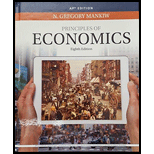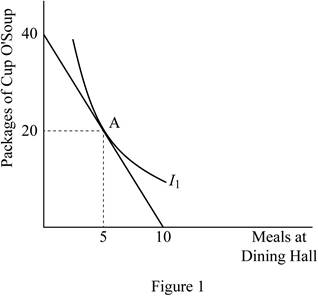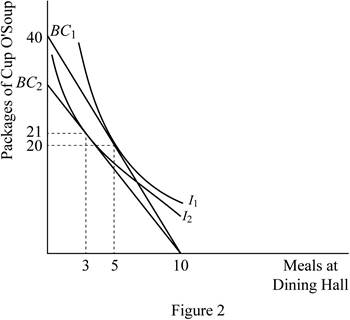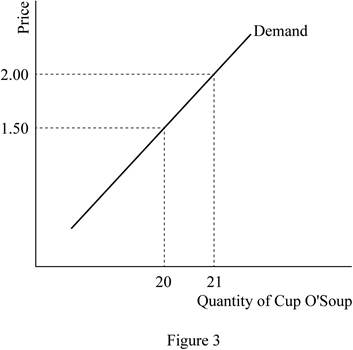
Concept explainers
Subpart (a):
The budget constraint and trade-off.
Subpart (a):
Explanation of Solution
When the wants and needs of a human are unlimited and the budget of an individual is limited, it will lead to a constraint of needs and this constraint raised is due to the limited budget is known as the budget constraint of an individual. Thus, the budget constraint is defined as the possible combination of goods and services that is purchased at a given price level with the entire income.
Here, the income of the person is given as $60, the price of one meal at dining hall is $6, and the price of cup 'o soup is $1.5. Thus, when the consumer spends her entire income on the meal in dining hall, the quantity that she receives can be calculated by dividing the income by the per meal price as follows:
Thus, when she spends all her income on meal from dining hall, she can buy 10 meals. When she spends all her income on the cup 'o soup meal, the quantity can be calculated by replacing the price of dining hall meal with that of cup 'o soup as follows:
Thus, when she spends all her income on the cup 'o soup meals, she can receive 40 cup 'o soup meals.
The budget constraint represents all the combinations of these two goods ranging between 10 dining hall meals and no cup 'o soup meal to no dining hall meals and 40 cup 'o soup meals. However in this case, the consumer spends her income equally on both of the commodities. Thus, she spends $30 each on dining hall meals and cup 'o soup meals. Thus, when the consumer spends $30 on the meal in dining hall, the quantity that she receives can be calculated by dividing the income by per meal price as follows:
Thus, when she spends $30 of her income on meal from dining hall, she can buy 5 meals. When she spends $30 of her income on the cup 'o soup meal, the quantity can be calculated by replacing the price of dining hall meal with that of cup 'o soup as follows:
Thus, when she spends $30 of her income on the cup 'o soup meals, she can receive 20 cup 'o soup meals. This will be the point of her consumption, when the income is equally spent on both commodities. The graphical representation shows this combination at point A and it is represented as follows:

Concept introduction:
Budget constraint: Budget constraint is defined as the possible combination of goods and services that is purchased at a given price level with the entire income.
Normal good: The goods whose quantity demanded increases, when the income of the consumer increases and vice versa.
Inferior good: The goods whose quantity demanded falls, when the income of the consumer increases and vice versa.
Giffen goods: They are the special cases of inferior goods in which an income effect overweighs the substitution effect.
Subpart (b):
The budget constraint and trade-off.
Subpart (b):
Explanation of Solution
When the price of the cup o' soup increases to $2 from $1.5, the vertical intercept of the student's budget constraint will shift downwards; this will flatten the budget constraint curve. When she spends all her income on the cup 'o soup meal, the quantity can be calculated by replacing the price of dining hall meal with that of cup 'o soup as follows:
Thus, when she spends all her income on the cup 'o soup meals, she can only receive 30 cup 'o soup meals. This flattens the budget constraint curve.
It is also said that at present she only spends 30 percent of her income on the dining hall meal, which means that the income spent on dining hall meal is only $18 and that spend on cup o' soup is $42. At this income spending distribution, she can purchase 3 units of dining hall meals and 21 units of cup o' soup meals. This new point can be illustrated as point B and it can be represented as follows:

Concept introduction:
Budget constraint: Budget constraint is defined as the possible combination of goods and services that is purchased at a given price level with the entire income.
Normal good: The goods whose quantity demanded increases, when the income of the consumer increases and vice versa.
Inferior good: The goods whose quantity demanded falls, when the income of the consumer increases and vice versa.
Giffen goods: They are the special cases of inferior goods in which an income effect overweighs the substitution effect.
Subpart (c):
The budget constraint and trade-off.
Subpart (c):
Explanation of Solution
The initial price of cup o' soup was $1.5, and the new price after the increase is $2. The initial quantity demanded of cup o' soup was 20 units; whereas after the increased price of the commodity, the quantity demanded is 21 units. This shows that the
Concept introduction:
Budget constraint: Budget constraint is defined as the possible combination of goods and services that is purchased at a given price level with the entire income.
Normal good: The goods whose quantity demanded increases, when the income of the consumer increases and vice versa.
Inferior good: The goods whose quantity demanded falls, when the income of the consumer increases and vice versa.
Giffen goods: They are the special cases of inferior goods in which an income effect overweighs the substitution effect.
Subpart (d):
The budget constraint and trade-off.
Subpart (d):
Explanation of Solution
The initial price of cup o' soup was $1.5, and the new price after the increase is $2. The initial quantity demanded of cup o' soup was 20 units denoted by point A; whereas after the increased price of the commodity, the quantity demanded is 21 units denoted by point B. This shows that the demand for the commodity will increase, when the price of the commodity increases. Thus, these two points can be graphically illustrated as follows:

Here, the demand for the cup o' soup increases, when its price increases, which means that the commodity is an inferior good. However at the same time, the income effect overweighs the substitution effect for the commodity, which is a special case of inferior goods, known as the Giffen goods. Thus, the cup o' soup is a Giffen good.
Concept introduction:
Budget constraint: Budget constraint is defined as the possible combination of goods and services that is purchased at a given price level with the entire income.
Normal good: The goods whose quantity demanded increases, when the income of the consumer increases and vice versa.
Inferior good: The goods whose quantity demanded falls, when the income of the consumer increases and vice versa.
Giffen goods: They are the special cases of inferior goods in which an income effect overweighs the substitution effect.
Want to see more full solutions like this?
Chapter 21 Solutions
Principles Of Economics, Ap Edition, 9781337292603, 1337292605, 2018
- In a small open economy with a floating exchange rate, the supply of real money balances is fixed and a rise in government spending ______ Group of answer choices Raises the interest rate so that net exports must fall to maintain equilibrium in the goods market. Cannot change the interest rate so that net exports must fall to maintain equilibrium in the goods market. Cannot change the interest rate so income must rise to maintain equilibrium in the money market Raises the interest rate, so that income must rise to maintain equilibrium in the money market.arrow_forwardSuppose a country with a fixed exchange rate decides to implement a devaluation of its currency and commits to maintaining the new fixed parity. This implies (A) ______________ in the demand for its goods and a monetary (B) _______________. Group of answer choices (A) expansion ; (B) contraction (A) contraction ; (B) expansion (A) expansion ; (B) expansion (A) contraction ; (B) contractionarrow_forwardAssume a small open country under fixed exchanges rate and full capital mobility. Prices are fixed in the short run and equilibrium is given initially at point A. An exogenous increase in public spending shifts the IS curve to IS'. Which of the following statements is true? Group of answer choices A new equilibrium is reached at point B. The TR curve will shift down until it passes through point B. A new equilibrium is reached at point C. Point B can only be reached in the absence of capital mobility.arrow_forward
- A decrease in money demand causes the real interest rate to _____ and output to _____ in the short run, before prices adjust to restore equilibrium. Group of answer choices rise; rise fall; fall fall; rise rise; fallarrow_forwardIf a country's policy makers were to continously use expansionary monetary policy in an attempt to hold unemployment below the natural rate , the long urn result would be? Group of answer choices a decrease in the unemployment rate an increase in the level of output All of these an increase in the rate of inflationarrow_forwardA shift in the Aggregate Supply curve to the right will result in a move to a point that is southwest of where the economy is currently at. Group of answer choices True Falsearrow_forward
- An oil shock can cause stagflation, a period of higher inflation and higher unemployment. When this happens, the economy moves to a point to the northeast of where it currently is. After the economy has moved to the northeast, the Federal Reserve can reduce that inflation without having to worry about causing more unemployment. Group of answer choices True Falsearrow_forwardThe long-run Phillips Curve is vertical which indicates Group of answer choices that in the long-run, there is no tradeoff between inflation and unemployment. that in the long-run, there is no tradeoff between inflation and the price level. None of these that in the long-run, the economy returns to a 4 percent level of inflation.arrow_forwardSuppose the exchange rate between the British pound and the U.S. dollar is £1 = $2.00. The U.S. government implementsU.S. government implements a contractionary fiscal policya contractionary fiscal policy. Illustrate the impact of this change in the market for pounds. 1.) Using the line drawing tool, draw and label a new demand line. 2.) Using the line drawing tool, draw and label a new supply line. Note: Carefully follow the instructions above and only draw the required objects.arrow_forward
- Just Part D please, this is for environmental economicsarrow_forward3. Consider a single firm that manufactures chemicals and generates pollution through its emissions E. Researchers have estimated the MDF and MAC curves for the emissions to be the following: MDF = 4E and MAC = 125 – E Policymakers have decided to implement an emissions tax to control pollution. They are aware that a constant per-unit tax of $100 is an efficient policy. Yet they are also aware that this policy is not politically feasible because of the large tax burden it places on the firm. As a result, policymakers propose a two- part tax: a per unit tax of $75 for the first 15 units of emissions an increase in the per unit tax to $100 for all further units of emissions With an emissions tax, what is the general condition that determines how much pollution the regulated party will emit? What is the efficient level of emissions given the above MDF and MAC curves? What are the firm's total tax payments under the constant $100 per-unit tax? What is the firm's total cost of compliance…arrow_forward2. Answer the following questions as they relate to a fishery: Why is the maximum sustainable yield not necessarily the optimal sustainable yield? Does the same intuition apply to Nathaniel's decision of when to cut his trees? What condition will hold at the equilibrium level of fishing in an open-access fishery? Use a graph to explain your answer, and show the level of fishing effort. Would this same condition hold if there was only one boat in the fishery? If not, what condition will hold, and why is it different? Use the same graph to show the single boat's level of effort. Suppose you are given authority to solve the open-access problem in the fishery. What is the key problem that you must address with your policy?arrow_forward
 Economics (MindTap Course List)EconomicsISBN:9781337617383Author:Roger A. ArnoldPublisher:Cengage Learning
Economics (MindTap Course List)EconomicsISBN:9781337617383Author:Roger A. ArnoldPublisher:Cengage Learning


 Exploring EconomicsEconomicsISBN:9781544336329Author:Robert L. SextonPublisher:SAGE Publications, Inc
Exploring EconomicsEconomicsISBN:9781544336329Author:Robert L. SextonPublisher:SAGE Publications, Inc Principles of MicroeconomicsEconomicsISBN:9781305156050Author:N. Gregory MankiwPublisher:Cengage Learning
Principles of MicroeconomicsEconomicsISBN:9781305156050Author:N. Gregory MankiwPublisher:Cengage Learning





